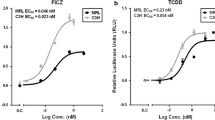Summary
A novel exonuclease protection mediated PCR assay (EPM-PCR) to detect the interaction of protein and DNA at a dioxin-responsive enhancer (DRE) upstream of the CYP1A1 gene in rat hepatic cytosol was established. A double-stranded DNA fragment containing two binding sites was designed and incubated with the aryl hydrocarbon receptor (AhR) transformed by 2,3,7,8-tetrachlorodibenzo-p dioxin (TCDD) to generate TCDD: AhR: DNA complex which could protect receptor-binding DNA against exonuclease III (Exo III) digestion. With Exo III treatment, free DNAs were digested and receptor-bound DNAs remained that could be amplified by PCR. By agarose gel electrophoreses a clear band (285bp) was detected using TCDD-treated sample, while nothing with control samples. To detect transformed AhR-DRE complex, 2 fmol DNAs and 3 ug cytosol proteins were found to be sufficient in the experiment. Compared with gel retardation assay, this new method is more sensitive for monitoring the Ah receptor-enhancer interaction without radioactive pollution.
Similar content being viewed by others
References
Poland A, Knutson J C. 2, 3, 7, 8-TCDD and related halogenated aromatic hydrocarbons: examination of the mechanism of toxicity. Annu Rev Pharmacol Toxicol, 1982, 22:517
Safe S H. Comparative toxicology and mechanism of action of polychlorinated dibenzo-p-dioxins and dibenzofurans. Annu Rev Pharmacol Toxicol, 1986, 26:371
Hankinson O. The Aryl hydrocarbon receptor complex. Annu Rev Pharm Toxicol, 1995, 35:307
Denison M S, Vella L M, Okey A B. Structure and function of Ah receptor for 2,3,7,8-tetrachlorodibenzop dioxin. Species difference in molecular properties of the receptors from mouse and rat hepatic cytosol. J Biol Chem, 1986, 261:3987
Bradford M M. A rapid, and sensitive method for the quantitation of microgram quantities of protein utilizing the principle of protein-dye binding. Anal Biochem, 1976, 72:248
Denison M S, Fisher J M, Whitlock J P Jr. Protein-DNA interaction at recognition sites for the dioxin Ahreceptor complex. J Biol Chem, 1989, 264:16 478
Denison, M S, Yao E F. Characterization of the interaction of transformed rat hepatic cytosolic Ah receptor with a dioxin responsive transcriptional enhancer. Arch Biochem Biophys, 1991, 284:158
Denison M S, Fisher J M, Witlock J P Jr. The DNA recognition sites for the dioxin-Ah receptor complex. J Biol. Chem, 1988, 263:17221
Aarts J M, Denison M S, Cox M Aet al. Species-specific antagonism of Ah receptor action by 2,2′5,5′-tetrachloro-and 2,2′,3,3′,4,4′-hexachlorobiphenyl. Eur J Pharmacol, 1995, 293:463
Bingye H, Hiroshi H, Takao S. Sensitive detection of the binding of E2F to its promoter by exonuclease III-and BssH III-protection PCR assays. J Biochem Biophys Methods, 1999, 39:85
Author information
Authors and Affiliations
Additional information
SUN Xi, female, born in 1970, Lecturer, M. D., Ph. D.
This project was supported by grants from National Natural Science Foundation of China (No. 20107002, 20377017).
Rights and permissions
About this article
Cite this article
Xi, S., Shunqing, X. Detection of interaction of binding affinity of aromatic hydrocarbon receptor to the specific DNA by exonuclease protection mediated PCR assay. Current Medical Science 25, 104–106 (2005). https://doi.org/10.1007/BF02831401
Received:
Published:
Issue Date:
DOI: https://doi.org/10.1007/BF02831401




